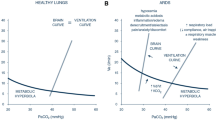Abstract
Treatment-emergent central sleep apnea (TECSA) is a distinct form of sleep-disordered breathing characterized by the development of central sleep apnea during the initiation of positive airway pressure (PAP) therapy in patients with obstructive sleep apnea. The exact mechanisms of TECSA are not clearly known; however, several theories have been proposed. Usually, TECSA is transient and self-limited, and disappears after continued PAP use. Nevertheless, patients with persistent TECSA have lower adherence to PAP therapy and are more likely to terminate therapy. Close follow up is necessary to assure that the emergent central events disappear with continued therapy. In patients with persistent TECSA, more advanced algorithms such as adaptive servo-ventilation have been shown to be very effective. In this brief review, we summarize the definition, prevalence, predictors, pathophysiology, and treatment approaches of TECSA.


Similar content being viewed by others
References
AASM. International Classification of Sleep Disorders (ICSD-3). 3rd ed. Chicago: American Academy of Sleep Medicine; 2014.
Randerath W, Verbraecken J, Andreas S, Arzt M, Bloch KE, Brack T, et al. Definition, discrimination, diagnosis and treatment of central breathing disturbances during sleep. Eur Respir J. 2017;49(1):1600959. doi:10.1183/13993003.00959-2016.
Castriotta RJ, Majid R. Complex sleep apnea. Sleep Med Clin. 2013;8:463–75.
Nigam G, Pathak C, Riaz M. A systematic review on prevalence and risk factors associated with treatment-emergent central sleep apnea. Ann Thorac Med. 2016;11(3):202–10. doi:10.4103/1817-1737.185761.
Liu D, Armitstead J, Benjafield A, Shao S, Malhotra A, Cistulli PA, et al. Trajectories of emergent central sleep apnea during CPAP therapy. Chest. 2017. doi:10.1016/j.chest.2017.06.010.
Berssenbrugge A, Dempsey J, Iber C, Skatrud J, Wilson P. Mechanisms of hypoxia-induced periodic breathing during sleep in humans. J Physiol. 1983;343:507–24.
Naughton MT. Loop gain in apnea: gaining control or controlling the gain? Am J Respir Crit Care Med. 2010;181(2):103–5. doi:10.1164/rccm.200909-1449ED.
White DP. Pathogenesis of obstructive and central sleep apnea. Am J Respir Crit Care Med. 2005;172(11):1363–70. doi:10.1164/rccm.200412-1631SO.
Malhotra A, Bertisch S, Wellman A. Complex sleep apnea: it isn’t really a disease. J Clin Sleep Med. 2008;4(5):406–8.
Wang J, Wang Y, Feng J, Chen BY, Cao J. Complex sleep apnea syndrome. Patient Prefer Adherence. 2013;7:633–41. doi:10.2147/PPA.S46626.
Mohan A, Henderson J, Mador MJ. Mandibular advancement device-emergent central sleep apnea can resolve spontaneously: a case report. J Clin Sleep Med. 2016;12(1):137–8. doi:10.5664/jcsm.5414.
Johnson KG, Johnson DC. Bilevel positive airway pressure worsens central apneas during sleep. Chest. 2005;128(4):2141–50. doi:10.1378/chest.128.4.2141.
Malfertheiner MV, Lerzer C, Kolb L, Heider K, Zeman F, Gfullner F, et al. Whom are we treating with adaptive servo-ventilation? A clinical post hoc analysis. Clin Res Cardiol Off J Ger Card Soc. 2017. doi:10.1007/s00392-017-1112-3.
Dellweg D, Kerl J, Hoehn E, Wenzel M, Koehler D. Randomized controlled trial of noninvasive positive pressure ventilation (NPPV) versus servoventilation in patients with CPAP-induced central sleep apnea (complex sleep apnea). Sleep. 2013;36(8):1163–71. doi:10.5665/sleep.2878.
Miao ZB, Wang YY, Sun R, Lei HL, Huang DJ, Huang LH, et al. Incidence and influencing factors of continuous positive airway pressure treatment-emergent central sleep apnea in the patients with obstructive sleep apnea syndrome at high altitude. Zhonghua yi xue za zhi. 2017;97(12):915–9. doi:10.3760/cma.j.issn.0376-2491.2017.12.008.
Moro M, Gannon K, Lovell K, Merlino M, Mojica J, Bianchi MT. Clinical predictors of central sleep apnea evoked by positive airway pressure titration. Nat Sci Sleep. 2016;8:259–66. doi:10.2147/NSS.S110032.
Author information
Authors and Affiliations
Corresponding author
Ethics declarations
Conflict of interest
The authors have no conflict of interest to declare.
Rights and permissions
About this article
Cite this article
BaHammam, A.S. Treatment-Emergent Central Sleep Apnea (Complex Sleep Apnea). Sleep Vigilance 1, 53–56 (2017). https://doi.org/10.1007/s41782-017-0015-8
Received:
Revised:
Accepted:
Published:
Issue Date:
DOI: https://doi.org/10.1007/s41782-017-0015-8




